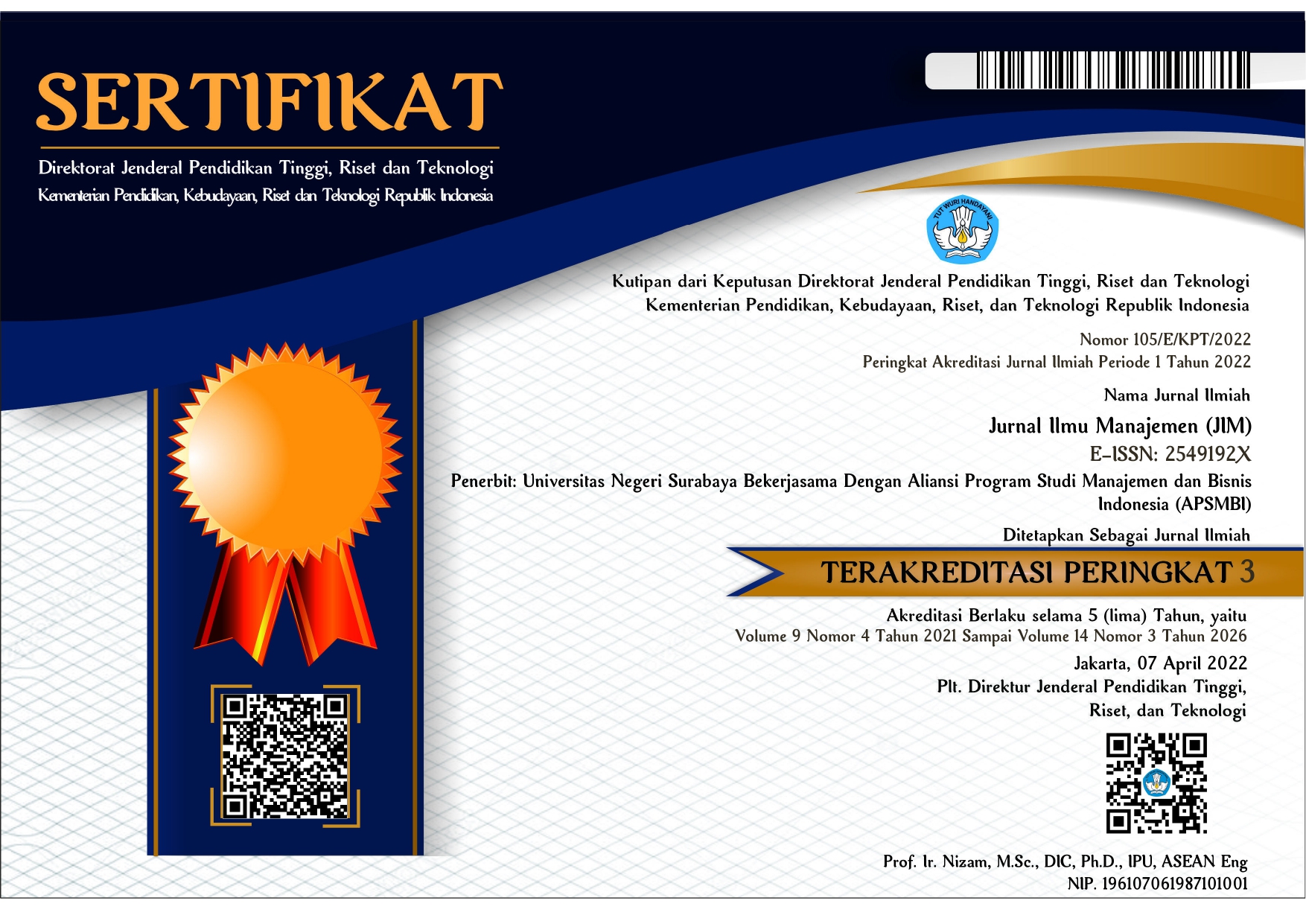Job Replacement Artifical Intelligence di Industri Jasa: Tinjauan Pustaka Sistematis
DOI:
https://doi.org/10.26740/jim.v10n3.p911-929Keywords:
artificial intelligence, human employment, job replacement, service task intelligenceAbstract
By performing a variety of activities, artificial intelligence (AI) is increasingly altering the service industry, providing a key source of innovation while jeopardizing human jobs. This double-edged effect is considered by the theory of AI job replacement. The idea provides four business intelligences necessary for service jobs — mechanical, analytical, intuitive, and empathic — and outlines how businesses should choose between humans and technology to complete these tasks. This study aims to describe how artificial intelligence (AI) is replacing human labour in the service industry and the sorts of business intelligence that AI will replace. Data from Scopus journal articles published between 2011 and 2021 will be analysed in a thorough literature review. VOS Viewer 1.6.17 was used to map and cluster (SLNA) the literatures collected over the last 10 years using Publish and Perish software. The network analysis of these articles showed keyword co-occurrence networks. According to the findings of the study, AI job replacement happens at the job level. First, AI augments a service job's work, a transitional stage known as augmentation, before eventually taking over all of a job's functions and eliminating the need for human labour. This study enrich the body of knowledge about the human resource management in industrial revolution and practical knowledge about talent management which suggest the service workers about the advancement of AI task substitution from low to high intelligence which has a predictable effect on their roles. Artificial Intelligence (AI) is gradually displacing human analytical skills, but the necessity of intuitive and empathic skills for service professionals is increasing, therefore new approaches of human–machine interaction are still required for delivering service excellence.
References
Acemoglu, D., & Restrepo, P. (2020). The wrong kind of AI? Artificial intelligence and the future of labour demand. Cambridge Journal of Regions, Economy and Society, 13(1), 25-35. https://doi.org/10.1093/cjres/rsz022.
Alrassi, J., Katsufrakis, P. J., & Chandran, L. (2020). Technology can augment, but not replace, critical human skills needed for patient care. Academic Medicine, 96(1), 37-43. DOI: 10.1097/ACM.0000000000003733.
Autor, David H. and David Dorn. (2013). The Growth of Low-Skill Service Jobs and the Polarization of the US Labor Market. American Economic Review, 103 (5), 1553-1597. DOI: 10.1257/aer.103.5.1553.
Colby, C. L., Mithas, S., & Parasuraman, A. (2016, June). Service robots: How ready are consumers to adopt and what drives acceptance. In The 2016 Frontiers in Service Conference, Bergen, Norway. DOI: 10.1007/978-3-658-31563-4
Davahli, M. R., Karwowski, W., Sonmez, S., & Apostolopoulos, Y. (2020). The hospitality industry in the face of the COVID-19 pandemic: Current topics and research methods. International Journal of Environmental Research and Public Health, 17(20), 7366. DOI: 10.3390/ijerph17207366.
Dolev, N., & Itzkovich, Y. (2020). In the ai era soft skills are the new hard skills. Artificial Intelligence and its Impact on Business, 55.
Davenport, Thomas H. and Julia Kirby. (2015). Beyond Automation. Harvard Business Review, June, 59-65.
de Sousa, W. G., de Melo, E. R. P., Bermejo, P. H. D. S., Farias, R. A. S., & Gomes, A. O. (2019). How and where is artificial intelligence in the public sector going? A literature review and research agenda. Government Information Quarterly, 36(4), 101392. https://doi.org/10.1016/j.giq.2019.07.004.
Edelman, D. C., & Singer, M. (2015). Competing on customer journeys. Harvard business review, 93(11), 88-100.
Fernandez, J (2018). The ball of wax we call HR analytics. Strategic HR Review, https://doi.org/10.1108/SHR-09-2018-0077
Fluss, Donna. (2017). The AI Revolution in Customer Service. Customer Relationship Management, January, 38.
Ford, M. R. (2009). The lights in the tunnel: Automation, accelerating technology and the economy of the future. Acculant Publishing.
Frey, C. B., & Osborne, M. A. (2017). The future of employment: How susceptible are jobs to computerisation?. Technological forecasting and social change, 114, 254-280.
Goleman, Daniel. (1996). Emotional Intelligence: Why It Can Matter More than IQ. London, UK: Bloomsbury Publishing.
Gupta, R., Tanwar, S., Tyagi, S., & Kumar, N. (2019). Tactile internet and its applications in 5G era: A comprehensive review. International Journal of Communication Systems, 32(14), e3981. https://doi.org/10.1002/dac.3981
Gursoy, D., Chi, O. H., Lu, L., & Nunkoo, R. (2019). Consumers acceptance of artificially intelligent (AI) device use in service delivery. International Journal of Information Management, 49, 157-169. https://doi.org/10.1016/j.ijinfomgt.2019.03.008.
Holotiuk, F, Pisani, F, & Moormann, J. (2017). The impact of blockchain technology on business models in the payments industry., aisel.aisnet.org, https://aisel.aisnet.org/wi2017/track09/paper/6/
Hongdao, Q., Bibi, S., Khan, A., Ardito, L., & Khaskheli, M. B. (2019). Legal technologies in action: The future of the legal market in light of disruptive innovations. Sustainability, 11(4), 1015.
Huang, M. H., & Rust, R. T. (2018). Artificial intelligence in service. Journal of Service Research, 21(2), 155-172.
Huang, M. H., & Rust, R. T. (2021). Engaged to a robot? The role of AI in service. Journal of Service Research, 24(1), 30-41. https://doi.org/10.1177/1094670520902266.
Ivanov, S., Gretzel, U., Berezina, K., Sigala, M., & Webster, C. (2019). Progress on robotics in hospitality and tourism: a review of the literature. Journal of Hospitality and Tourism Technology, https://doi.org/10.1108/JHTT-08-2018-0087.
Kim, M. (2007). Challenges on the development of robotic intelligence. In RO-MAN 2007-The 16th IEEE International Symposium on Robot and Human Interactive Communication (pp. 344-344). IEEE. https://doi.org/10.1016/j.robot.2014.09.031.
Kumar, S., & Qadeer, M. A. (2012). Application of AI in home automation. International Journal of Engineering and Technology, 4(6), 803.
Kumar, V., Rajan, B., Venkatesan, R., & Lecinski, J. (2019). Understanding the role of artificial intelligence in personalized engagement marketing. California Management Review, 61(4), 135-155, https://doi.org/10.1177/0008125619859317
Kumar, S., Kar, A. K., & Ilavarasan, P. V. (2021). Applications of text mining in services management: A systematic literature review. International Journal of Information Management Data Insights, 1(1),100008. https://doi.org/10.1016/j.jjimei.2021.100008.
Li, J. J., Bonn, M. A., & Ye, B. H. (2019). Hotel employee's artificial intelligence and robotics awareness and its impact on turnover intention: The moderating roles of perceived organizational support and competitive psychological climate. Tourism Management, 73, 172-181. https://doi.org/10.1016/j.tourman.2019.02.006
Li, X., Zhang, W., Ding, Q., & Sun, J. Q. (2020). Intelligent rotating machinery fault diagnosis based on deep learning using data augmentation. Journal of Intelligent Manufacturing, 31(2), 433-452, https://doi.org/10.1007/s10845-018-1456-1
Limna, P. (2022). Artificial Intelligence (AI) in the hospitality industry: A review article. International Journal of Computing Sciences Research. Advance online publication, 6(6), 1-12. DOI: 10.25147/ijcsr.2017.001.1.103.
Makridakis, S. (2017). The forthcoming Artificial Intelligence (AI) revolution: Its impact on society and firms. Futures, 90, 46-60. https://doi.org/10.1016/j.futures.2017.03.006
Manikas, I., Sundarakani, B., & Iakimenko, V. (2019). Time-based responsive logistics for a maintenance service network: A case study of an automated teller manufacturer. Journal of Quality in Maintenance Engineering, 119-150.
Manzalini, A. (2020). Quantum communications in future networks and services. Quantum Reports, 2(1), 221-232.
McDermott, D. (2007). Artificial intelligence and consciousness. The Cambridge handbook of consciousness, 117-150.
Mishra, K. N., & Chakraborty, C. (2020). A novel approach toward enhancing the quality of life in smart cities using clouds and IoT-based technologies. In Digital Twin Technologies and Smart Cities (pp. 19-35). Springer, Cham. https://doi.org/10.1007/978-3-030-18732-3_2
Mogaji, E., Soetan, T. O., & Kieu, T. A. (2020). The implications of artificial intelligence on the digital marketing of financial services to vulnerable customers. Australasian Marketing Journal, j-ausmj, https://doi.org/10.1016/j.ausmj.2020.05.003
Moniruzzaman, M., Khezr, S., Yassine, A., & Benlamri, R. (2020). Blockchain for smart homes: Review of current trends and research challenges. Computers & Electrical Engineering, 83, 106585.
Pew Research Center. (2017). Sharp partisan divisions in views of national institutions (U.S. Politics & Policy). Washington, D.C.: Pew Research Center. Retrieved June 1, 2021 from <http://www.people-press.org/2017/07/10/sharp-partisan- divisions-in-views-of-national-institutions/>
Pfeuffer, N., Benlian, A., Gimpel, H., & Hinz, O. (2019). Anthropomorphic information systems. Business & Information Systems Engineering, 61(4), 523-533, https://doi.org/10.1007/s12599-019-00599-y
Ravi, K., & Ravi, V. (2015). A survey on opinion mining and sentiment analysis: tasks, approaches and applications. Knowledge-based systems, 89, 14-46. https://doi.org/10.1016/j.knosys.2015.06.015
Riedel, A., Mulcahy, R. and Northey, G. (2022), "Feeling the love? How consumer's political ideology shapes responses to AI financial service delivery", International Journal of Bank Marketing, Vol. 40 No. 6, pp. 1102-1132. https://doi.org/10.1108/IJBM-09-2021-0438.
Robertson, J. (2014). Human rights vs. robot rights: Forecasts from Japan. Critical Asian Studies, 46(4), 571-598. https://doi.org/10.1080/14672715.2014.960707
Roy, S. K., Singh, G., Hope, M., Nguyen, B., & Harrigan, P. (2019). The rise of smart consumers: role of smart servicescape and smart consumer experience co-creation. Journal of Marketing Management, 35(15-16), 1480-1513, https://doi.org/10.1080/0267257X.2019.1680569
Rust, R. T., & Huang, M. H. (2014). The service revolution and the transformation of marketing science. Marketing Science, 33(2), 206-221.
Sawhney, M. (2016). Putting products into services. Harvard Business Review, 2016 (September).
Shanmuganathan, M. (2020). Behavioural finance in an era of artificial intelligence: Longitudinal case study of robo-advisors in investment decisions. Journal of Behavioral and Experimental Finance, 27, 100297.
Shah, D., Dixit, R., Shah, A., Shah, P., & Shah, M. (2020). A comprehensive analysis regarding several breakthroughs based on computer intelligence targeting various syndromes. Augmented Human Research, 5(1), 1-12. https://doi.org/10.1007/s41133-020-00033-z
Singh, S., Sharma, P. K., Yoon, B., Shojafar, M., Cho, G. H., & Ra, I. H. (2020). Convergence of blockchain and artificial intelligence in IoT network for the sustainable smart city. Sustainable Cities and Society, 63, 102364.
Talaviya, T., Shah, D., Patel, N., Yagnik, H., & Shah, M. (2020). Implementation of artificial intelligence in agriculture for optimisation of irrigation and application of pesticides and herbicides. Artificial Intelligence in Agriculture, 4, 58-73.
Taneri, G. U. (2020). Artificial Intelligence & Higher Education: Towards Customized Teaching and Learning, and Skills for an AI World of Work. Research & Occasional Paper Series: CSHE. 6.2020. Center for Studies in Higher Education.
Tavakoli, R., & Wijesinghe, S. N. (2019). The evolution of the web and netnography in tourism: A systematic review. Tourism Management Perspectives, 29, 48-55.
Teece, D. (2019). A Capability Theory of the Firm: an Economics and (Strategic) Management Perspective. New Zealand Economic Papers, 53(1), 1-43. https://doi.org/10.1080/00779954.2017.1371208.
Troshani, I., Rao Hill, S., Sherman, C., & Arthur, D. (2021). Do we trust in AI? Role of anthropomorphism and intelligence. Journal of Computer Information Systems, 61(5), 481-491, https://doi.org/10.1080/08874417.2020.1788473
Ukpabi, D. C., Aslam, B., & Karjaluoto, H. (2019). Chatbot adoption in tourism services: A conceptual exploration. In Robots, artificial intelligence, and service automation in travel, tourism and hospitality. Emerald Publishing Limited, https://doi.org/10.1108/978-1-78756-687-320191006
Van Eck, N. J., & Waltman, L. (2010). Software survey: VOSviewer, a computer program for bibliometric mapping. scientometrics, 84(2), 523-538.
Van Eck, N. J., & Waltman, L. (2013). VOSviewer manual. Leiden: Univeristeit Leiden, 1(1), 1-53.
Visintin, F, Porcelli, I, & Ghini, A (2014). Applying discrete event simulation to the design of a service delivery system in the aerospace industry: a case study. Journal of Intelligent Manufacturing, Springer, https://doi.org/10.1007/s10845-013-0742-1
Vla?i?, B., Corbo, L., e Silva, S. C., & Dabi?, M. (2021). The evolving role of artificial intelligence in marketing: A review and research agenda. Journal of Business Research, 128, 187-203.
Wang, W., Kumar, N., Chen, J., Gong, Z., Kong, X., Wei, W., & Gao, H. (2020). Realizing the potential of the internet of things for smart tourism with 5G and AI. IEEE network, 34(6), 295-301.
Wedel, M., & Kannan, P. K. (2016). Marketing analytics for data-rich environments. Journal of Marketing, 80(6), 97-121.
Zhang, P., Zhang, Q., Liu, F., Li, J., Cao, N., & Song, C. (2017). The construction of the integration of water and fertilizer smart water saving irrigation system based on big data. In 2017 IEEE international conference on computational science and engineering (CSE) and IEEE international conference on embedded and ubiquitous computing (EUC) (Vol. 2, pp. 392-397). IEEE.
Zupic, I., & ?ater, T. (2015). Bibliometric methods in management and organisation. Organisational research methods, 18(3), 429-472.
Zsarnoczky, M. (2018). The digital future of the tourism & hospitality industry. Boston Hospitality Review, 6, 1-9.
Downloads
Published
How to Cite
Issue
Section
License

This work is licensed under a Creative Commons Attribution-NonCommercial 4.0 International License.
 Abstract views: 3184
,
Abstract views: 3184
, PDF Downloads: 8762
PDF Downloads: 8762










